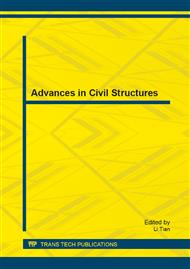p.515
p.519
p.524
p.528
p.532
p.536
p.541
p.545
p.550
Structural Damage Assessment by an Improved Flexibility Sensitivity Method
Abstract:
Structural damage detection using vibration modes has become a very important research area in recent years. In this paper, an improved generalized flexibility sensitivity method is presented for structural damage identification. The existing generalized flexibility method is firstly reviewed and then an improved technique is proposed. In this contribution, a simple accelerated formula is developed to improve the accuracy of the generalized flexibility method. With the introduction of the accelerated formula, the proposed method is able to achieve more accurate results than that obtained by the original generalized flexibility method without any high-order analysis or multi-iterations. The effectiveness of the proposed method is illustrated using simulated data on a published numerical example. From the numerical results, it can be conclued that the proposed new method is very efficient with only the first frequency and its corresponding mode shape. It has been shown that the proposed procedure is simple to implement and may be useful for structural damage identification.
Info:
Periodical:
Pages:
532-535
Citation:
Online since:
August 2013
Authors:
Keywords:
Price:
Сopyright:
© 2013 Trans Tech Publications Ltd. All Rights Reserved
Share:
Citation:


